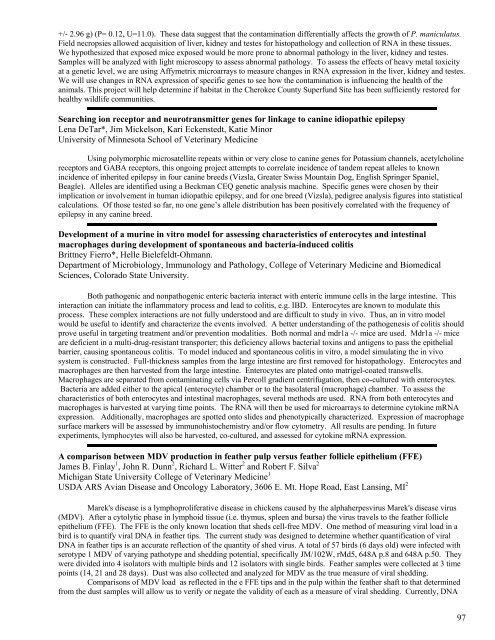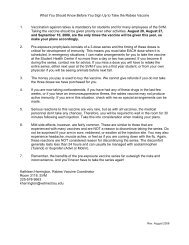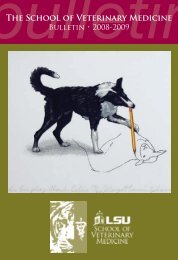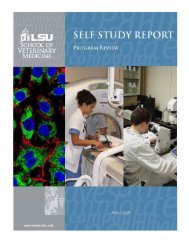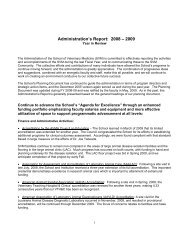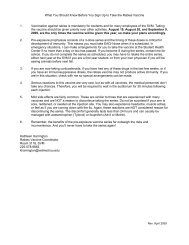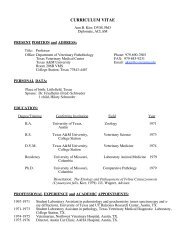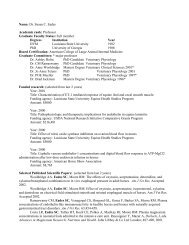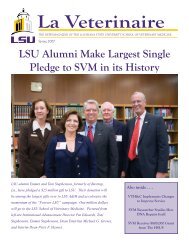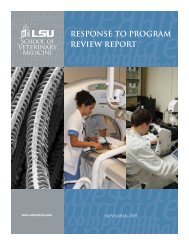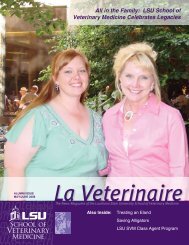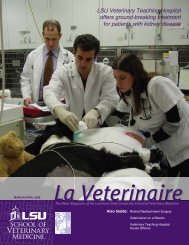Markers <strong>of</strong> Oxidative Stress in plasma, laminar tissue, and skin <strong>of</strong> horses administered black walnutextractBrent Credille*, Laura Riggs1, Karolina Burda, Thomas Krunkosky.Department <strong>of</strong> Anatomy and Radiology, Department <strong>of</strong> Large Animal <strong>Medicine</strong>1, College <strong>of</strong> <strong>Veterinary</strong><strong>Medicine</strong>, University <strong>of</strong> Georgia, Athens GA 30602Evolving from multiple etiologies, laminitis is a complicated and somewhat poorly understood condition that affectsnumerous horses worldwide. Recent research suggests that oxidative stress may play a role in the acute phase <strong>of</strong> laminitis.Collectively, studies have demonstrated an increase in activated neutrophils, reactive oxygen species (ROS) andmyeloperoxidase levels in plasma, skin and laminar tissue from laminitic horses induced with Black Walnut HeartwoodExtract (BWHE). As a consequence <strong>of</strong> increased myeloperoxidase release and ROS production in skin and laminar tissue,multiple oxidant sensitive cellular signaling pathways may be upregulated. Our general hypothesis is that since the skin andthe lamina share a common developmental origin as part <strong>of</strong> the integument, both <strong>of</strong> these tissues are affected by the sameinflammatory events during the course <strong>of</strong> laminitis. With this in mind, the long term objective <strong>of</strong> this project is to develop anovel skin biopsy technique to detect animals at risk for developing laminitis. Specifically, we hypothesize that nitrotyrosineand 8-isoprostane levels, which are both markers <strong>of</strong> oxidative stress, are increased in tissues <strong>of</strong> laminitic horses. To test ourhypothesis, tissue samples from control horses and horses in which laminitis has been induced using BWHE will beinvestigated. Utilizing slot blot, western blot, and enzyme immunoassay (EIA) techniques, we will attempt to quantify theexpression <strong>of</strong> these compounds. The results <strong>of</strong> this study may help assist in the detection <strong>of</strong> acute laminitis and aid indeveloping more effective treatments during the early stages <strong>of</strong> the disease. Understanding the role <strong>of</strong> oxidative stress in skinand laminar tissue obtained from BWHE induced laminitic horses will help us understand the physiological events that leadto the acute onset <strong>of</strong> laminitis and assist veterinarians in detecting horses at risk for developing laminitis and institutetreatment before serious damage has occurred to the ho<strong>of</strong> tissue.A Novel Approach to Atypical Interstitial Pneumonia in feedlot cattle: Pancreatitis as an Etiology.Keith D. DeDonder* and Daniel U. ThomsonDepartment <strong>of</strong> Clinical Sciences, College <strong>of</strong> <strong>Veterinary</strong> <strong>Medicine</strong>, Kansas <strong>State</strong> University, Manhattan, KS 66506Atypical Interstitial Pneumonia (AIP) is a sporadic, respiratory disease <strong>of</strong> feedlot cattle. According to recentsurveys, AIP is the second leading cause <strong>of</strong> mortality in the feedlot. Treatment <strong>of</strong> AIP is unrewarding. Therefore prevention<strong>of</strong> this syndrome is key for saving millions <strong>of</strong> dollars for the beef industry. A specific etiology <strong>of</strong> AIP in feeder cattle to dateis unknown. It is agreed that the cause <strong>of</strong> AIP in feedlot calves is complex, probably involving many factors. A wide array<strong>of</strong> infectious and noninfectious etiologies have been proposed including but not limited to: feeding melengestrol acetate(MGA), Bovine Respiratory Syncytial Virus (BRSV), hypersensitivities, allergens, dust, toxic gases, bacterial pneumonia,and endotoxins. Rat models studying an equivalent disease in humans (Acute Respiratory Distress Syndrome or ARDS)have shown a link between pancreatitis and lung pathology similar to AIP. Feeder cattle are exposed to diets rich in solublecarbohydrates and fats 150 to 250 days. It has also been confirmed that cattle succumbing to AIP do so later in the feedingperiod (> 90 DOF) after some type <strong>of</strong> digestive upset. The type <strong>of</strong> diet and timing <strong>of</strong> the syndrome would lead one to thinkthat pancreatitis could be a possibility. Therefore the objectives <strong>of</strong> this study are to determine the prevalence <strong>of</strong> acute orsubacute pancreatitis in cattle confirmed with AIP. Live animals suffering from AIP will be transported to the Kansas <strong>State</strong>University Diagnostic Laboratory for a complete necropsy investigation. A complete diagnostic work up will be doneincluding complete blood counts, serum chemistry, bacteriology and histological examination. Results from this pilot studywill be used to direct future studies correlating AIP with pancreatitis.Ecotoxicogenomics <strong>of</strong> Small Mammal Populations in the Tri-<strong>State</strong> Mining DistrictJoy Delamaide 1 *, Lindsey Crawford 1 , Samantha M. Wisely Ph.D. 2 , Susan J. Brown Ph.D. 2College <strong>of</strong> <strong>Veterinary</strong> <strong>Medicine</strong>, Kansas <strong>State</strong> University 1Division <strong>of</strong> Biology, Kansas <strong>State</strong> University 2The Tri-<strong>State</strong> Mining District includes Cherokee County, which flourished from 1870-1970 because <strong>of</strong> its pr<strong>of</strong>itablelead and zinc production. Waste produced during mining exposed surrounding habitats to high levels <strong>of</strong> lead, zinc, andcadmium. The contamination was remediated for human habitation via the Cherokee County Superfund. Ecotoxicologicalassessment <strong>of</strong> the small mammal community will help evaluate if remediation was sufficient to restore healthy habitats.Peromyscus maniculatus and P. leucopus were trapped in the Neosho Wildlife Area (control) and Galena, KS (treatment).We trapped at each site for six nights using Sherman Live Traps. Fifty-nine animals were trapped, including P. leucopus, P.maniculatus, and Neotoma floridana. A Shannon Diversity index <strong>of</strong> 1.3 was calculated for the control site, compared to anindex <strong>of</strong> 1.2 for the treatment site. P. maniculatus collected in Galena had an average shorter left hind foot length (17.2 +/_0.2 mm (average +/- SE)) than those found at the control site (19.8 +/- 1.1 mm) (P= 0.04, U= 3.5). However, P. maniculatusin Galena did not have a lower average body weight (15.22 +/- 0.57 g) than P. maniculatus collected at the control site (20.896
+/- 2.96 g) (P= 0.12, U=11.0). These data suggest that the contamination differentially affects the growth <strong>of</strong> P. maniculatus.Field necropsies allowed acquisition <strong>of</strong> liver, kidney and testes for histopathology and collection <strong>of</strong> RNA in these tissues.We hypothesized that exposed mice exposed would be more prone to abnormal pathology in the liver, kidney and testes.Samples will be analyzed with light microscopy to assess abnormal pathology. To assess the effects <strong>of</strong> heavy metal toxicityat a genetic level, we are using Affymetrix microarrays to measure changes in RNA expression in the liver, kidney and testes.We will use changes in RNA expression <strong>of</strong> specific genes to see how the contamination is influencing the health <strong>of</strong> theanimals. This project will help determine if habitat in the Cherokee County Superfund Site has been sufficiently restored forhealthy wildlife communities.Searching ion receptor and neurotransmitter genes for linkage to canine idiopathic epilepsyLena DeTar*, Jim Mickelson, Kari Eckenstedt, Katie MinorUniversity <strong>of</strong> Minnesota <strong>School</strong> <strong>of</strong> <strong>Veterinary</strong> <strong>Medicine</strong>Using polymorphic microsatellite repeats within or very close to canine genes for Potassium channels, acetylcholinereceptors and GABA receptors, this ongoing project attempts to correlate incidence <strong>of</strong> tandem repeat alleles to knownincidence <strong>of</strong> inherited epilepsy in four canine breeds (Vizsla, Greater Swiss Mountain Dog, English Springer Spaniel,Beagle). Alleles are identified using a Beckman CEQ genetic analysis machine. Specific genes were chosen by theirimplication or involvement in human idiopathic epilepsy, and for one breed (Vizsla), pedigree analysis figures into statisticalcalculations. Of those tested so far, no one gene’s allele distribution has been positively correlated with the frequency <strong>of</strong>epilepsy in any canine breed.Development <strong>of</strong> a murine in vitro model for assessing characteristics <strong>of</strong> enterocytes and intestinalmacrophages during development <strong>of</strong> spontaneous and bacteria-induced colitisBrittney Fierro*, Helle Bielefeldt-Ohmann.Department <strong>of</strong> Microbiology, Immunology and Pathology, College <strong>of</strong> <strong>Veterinary</strong> <strong>Medicine</strong> and BiomedicalSciences, Colorado <strong>State</strong> University.Both pathogenic and nonpathogenic enteric bacteria interact with enteric immune cells in the large intestine. Thisinteraction can initiate the inflammatory process and lead to colitis, e.g. IBD. Enterocytes are known to modulate thisprocess. These complex interactions are not fully understood and are difficult to study in vivo. Thus, an in vitro modelwould be useful to identify and characterize the events involved. A better understanding <strong>of</strong> the pathogenesis <strong>of</strong> colitis shouldprove useful in targeting treatment and/or prevention modalities. Both normal and mdr1a -/- mice are used. Mdr1a -/- miceare deficient in a multi-drug-resistant transporter; this deficiency allows bacterial toxins and antigens to pass the epithelialbarrier, causing spontaneous colitis. To model induced and spontaneous colitis in vitro, a model simulating the in vivosystem is constructed. Full-thickness samples from the large intestine are first removed for histopathology. Enterocytes andmacrophages are then harvested from the large intestine. Enterocytes are plated onto matrigel-coated transwells.Macrophages are separated from contaminating cells via Percoll gradient centrifugation, then co-cultured with enterocytes.Bacteria are added either to the apical (enterocyte) chamber or to the basolateral (macrophage) chamber. To assess thecharacteristics <strong>of</strong> both enterocytes and intestinal macrophages, several methods are used. RNA from both enterocytes andmacrophages is harvested at varying time points. The RNA will then be used for microarrays to determine cytokine mRNAexpression. Additionally, macrophages are spotted onto slides and phenotypically characterized. Expression <strong>of</strong> macrophagesurface markers will be assessed by immunohistochemistry and/or flow cytometry. All results are pending. In futureexperiments, lymphocytes will also be harvested, co-cultured, and assessed for cytokine mRNA expression.A comparison between MDV production in feather pulp versus feather follicle epithelium (FFE)James B. Finlay 1 , John R. Dunn 2 , Richard L. Witter 2 and Robert F. Silva 2Michigan <strong>State</strong> University College <strong>of</strong> <strong>Veterinary</strong> <strong>Medicine</strong> 1USDA ARS Avian Disease and Oncology Laboratory, 3606 E. Mt. Hope Road, East Lansing, MI 2Marek's disease is a lymphoproliferative disease in chickens caused by the alphaherpesvirus Marek's disease virus(MDV). After a cytolytic phase in lymphoid tissue (i.e. thymus, spleen and bursa) the virus travels to the feather follicleepithelium (FFE). The FFE is the only known location that sheds cell-free MDV. One method <strong>of</strong> measuring viral load in abird is to quantify viral DNA in feather tips. The current study was designed to determine whether quantification <strong>of</strong> viralDNA in feather tips is an accurate reflection <strong>of</strong> the quantity <strong>of</strong> shed virus. A total <strong>of</strong> 57 birds (6 days old) were infected withserotype 1 MDV <strong>of</strong> varying pathotype and shedding potential, specifically JM/102W, rMd5, 648A p.8 and 648A p.50. Theywere divided into 4 isolators with multiple birds and 12 isolators with single birds. Feather samples were collected at 3 timepoints (14, 21 and 28 days). Dust was also collected and analyzed for MDV as the true measure <strong>of</strong> viral shedding.Comparisons <strong>of</strong> MDV load as reflected in the e FFE tips and in the pulp within the feather shaft to that determinedfrom the dust samples will allow us to verify or negate the validity <strong>of</strong> each as a measure <strong>of</strong> viral shedding. Currently, DNA97
- Page 1 and 2:
2006 MERCK/MERIALNATIONAL VETERINAR
- Page 6 and 7:
3:00-3:30 pm BreakNovel therapy for
- Page 8 and 9:
KEYNOTE SPEAKERRonald Veazey, D.V.M
- Page 10 and 11:
Mini Symposium II:Fish Research: A
- Page 12 and 13:
David G. Baker, D.V.M., M.S., Ph.D.
- Page 14 and 15:
Konstantin G. Kousoulas, Ph.D.Profe
- Page 16 and 17:
Joseph Francis, B.V.Sc., M.V.Sc., P
- Page 18 and 19:
dogs with cancer, the potential rol
- Page 20 and 21:
2006 MERCK/MERIALVETERINARY SCHOLAR
- Page 22 and 23:
YOUNG INVESTIGATOR AWARD HONORABLE
- Page 24 and 25:
Mammary epithelial-specific deletio
- Page 26 and 27:
2006 MERCK/MERIALVETERINARY SCHOLAR
- Page 28:
Variation in Q-Tract Length of the
- Page 34:
Novel therapy for humoral hypercalc
- Page 38:
ALTERNATE:Micron-scale membrane sub
- Page 42 and 43:
ABSTRACT TITLES LISTED BY CATEGORY
- Page 44 and 45:
19. A pilot study of cigarette smok
- Page 46 and 47: 36. Development of a murine in vitr
- Page 48 and 49: ABSTRACT TITLES LISTED BY CATEGORY
- Page 50 and 51: 71. Identification and characteriza
- Page 52 and 53: 85. Age and Gender Influence Ventil
- Page 54 and 55: ABSTRACT TITLES LISTED BY CATEGORY
- Page 56 and 57: 2006 MERCK/MERIALVETERINARY SCHOLAR
- Page 58 and 59: 10. Preliminary estimation of risk
- Page 60 and 61: ABSTRACT TITLES LISTED BY CATEGORY
- Page 62 and 63: 47. Osteoprotegerin and Receptor Ac
- Page 64 and 65: 61. A Comparison of Interaction Pat
- Page 66 and 67: ABSTRACT TITLES LISTED BY CATEGORY
- Page 68 and 69: ABSTRACT TITLES LISTED BY CATEGORY
- Page 70 and 71: ABSTRACT TITLES LISTED BY CATEGORY
- Page 72 and 73: 2006 MERCK/MERIALVETERINARY SCHOLAR
- Page 74 and 75: used to label avian heterophils for
- Page 76 and 77: obtained via analysis of time and d
- Page 78 and 79: 0.71mg/dL; p=0.001). Values for hem
- Page 80 and 81: mass and fecundity in prespawning w
- Page 82 and 83: Equine Hoof Laminae Tissue Collecti
- Page 84 and 85: Aspiration Pneumonia in DogsDavid A
- Page 86 and 87: Distortion Product Otoacoustic Emis
- Page 88 and 89: tyrosine phosphorylation is measure
- Page 90 and 91: the gravid and non-gravid females t
- Page 92 and 93: egulatory function as its ortholog,
- Page 94 and 95: PATHOLOGY, TOXICOLOGY, AND ONCOLOGY
- Page 98 and 99: has been isolated from all samples
- Page 100 and 101: Matrix metalloproteinase secretion
- Page 102 and 103: Reproductive performance, neonatal
- Page 104 and 105: control to determine the efficiency
- Page 106 and 107: Enhancing the Quality and Reliabili
- Page 108 and 109: grade II MCTs into groups with good
- Page 110 and 111: Transcriptional Regulation of the I
- Page 112 and 113: MICROBIOLOGY AND IMMUNOLOGY (SESSIO
- Page 114 and 115: colonization of the mutant and 6 re
- Page 116 and 117: digestive tracts of these and other
- Page 118 and 119: 100 pfu BRSV. The results show that
- Page 120 and 121: Inhibition of Microneme Secretion i
- Page 122 and 123: Adherent bacilli were present in th
- Page 124 and 125: isolated to analyze cytokine gene e
- Page 126 and 127: purified, viral RNA was extracted a
- Page 128 and 129: The effects of co-engagement of TLR
- Page 130 and 131: Occurrence of Leptospira Vaccine Fa
- Page 132 and 133: undifferentiated catecholaminergic
- Page 134 and 135: the concept that the greater detoxi
- Page 136 and 137: quantitative PCR using gene targets
- Page 138 and 139: Rotenone Induced Dopamine Neuron De
- Page 140 and 141: decrease in serum cortisol, with a
- Page 142 and 143: and detrimental impacts on the brai
- Page 144 and 145: actions of cells prior to embryo de
- Page 146 and 147:
Utilizing cDNA Subtraction to Exami
- Page 148 and 149:
expression in unilaterally pregnant
- Page 150 and 151:
Salmonella is increased. Poultry sa
- Page 152 and 153:
exports. The estimated prevalence o
- Page 154 and 155:
eeding grounds near Minnedosa, MB s
- Page 156 and 157:
(PBMC) were isolated using commerci
- Page 158 and 159:
2006 MERCK/MERIALVETERINARY SCHOLAR
- Page 160 and 161:
Trainees acquire in-depth knowledge
- Page 162 and 163:
comparative pathology and/or resear
- Page 164 and 165:
Department of Veterinary Bioscience
- Page 166 and 167:
PhD, Director, Center for Comparati
- Page 168 and 169:
2006 MERCK/MERIALVETERINARY SCHOLAR
- Page 170 and 171:
MICHIGAN STATEUNIVERSITYJames Crawf
- Page 172:
UNIVERSITY OFPENNSYLVANIALindsay Th


